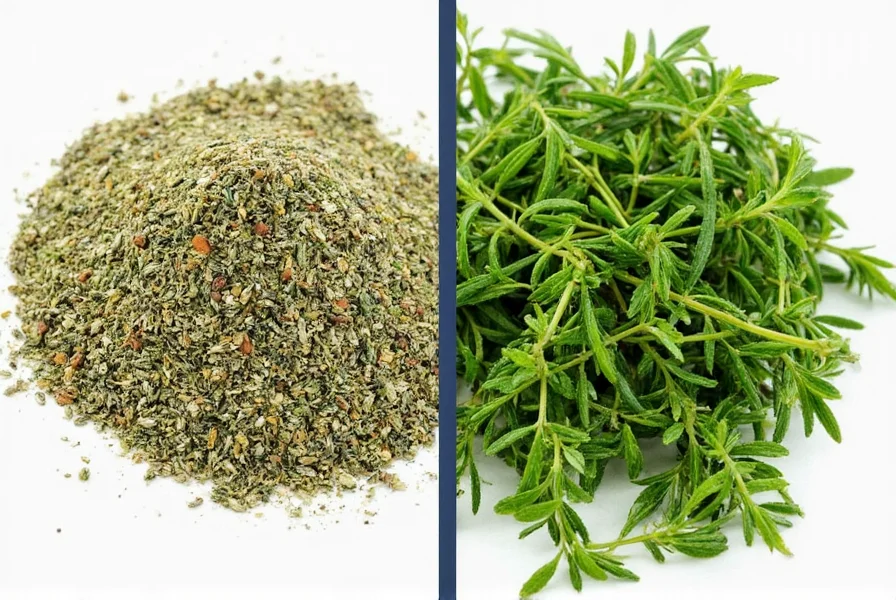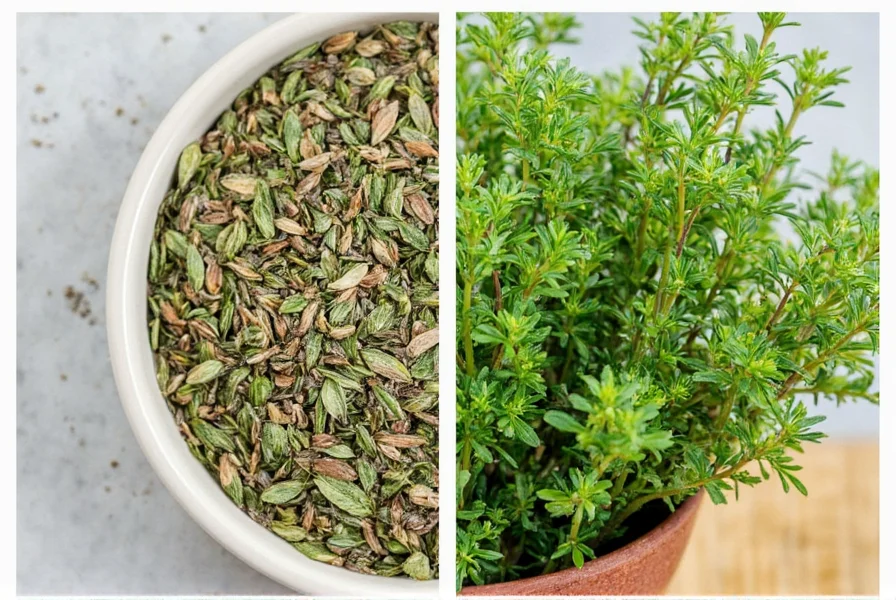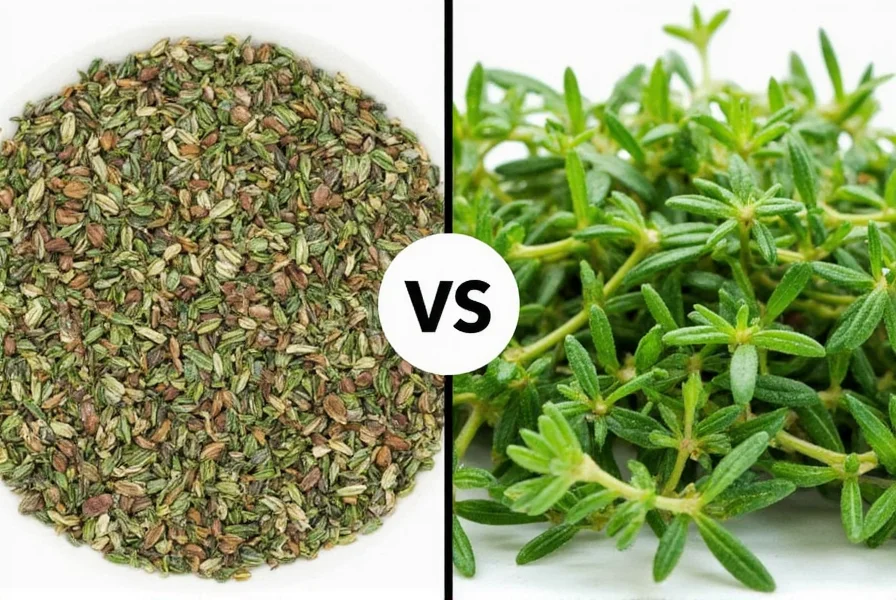Dried thyme and fresh thyme differ significantly in flavor intensity, shelf life, and best cooking applications. For quick dishes and garnishes, use fresh thyme for its bright, floral notes. For slow-cooked recipes like stews and roasts, dried thyme provides a more concentrated, earthy flavor. Remember: 1 teaspoon of dried thyme equals about 1 tablespoon of fresh thyme in substitution.

Table of Contents
- Introduction
- Flavor Profiles: What’s the Difference?
- Shelf Life & Storage: Which One Lasts Longer?
- Cooking Tips: When to Use Dried vs Fresh Thyme
- Buying Guide: How to Choose the Best Thyme
- Culinary Uses Across the World
- Frequently Asked Questions
- Conclusion
Introduction
Thyme is a versatile herb used globally, but choosing between dried and fresh forms depends on your recipe needs. This guide covers key differences to help you make informed decisions.
Flavor Profiles: What’s the Difference?
| Attribute | Fresh Thyme | Dried Thyme |
|---|---|---|
| Flavor Intensity | Mild, herbal, slightly minty | Concentrated, earthy, savory |
| Aroma | Delicate, floral | Strong, woody, robust |
| Best For | Garnishes, short-cook dishes | Long-cooked dishes like stews and roasts |
Fresh thyme offers a brighter, more delicate flavor that shines when added at the end of cooking or used raw. Dried thyme provides a stronger, more robust taste ideal for simmering recipes where flavors infuse over time.

Shelf Life & Storage: Which One Lasts Longer?
Dried thyme lasts 1-3 years when stored properly, while fresh thyme only stays fresh for 7-10 days. Here’s how to maximize shelf life:
- Fresh Thyme: Store in a damp paper towel inside a sealed bag or upright in water like a bouquet. Discard if leaves turn yellow or slimy.
- Dried Thyme: Keep in an airtight container away from light and moisture. Check aroma monthly; if weak, replace.
Cooking Tips: When to Use Dried vs Fresh Thyme
Key substitution rule: 1 teaspoon dried thyme = 1 tablespoon fresh thyme. Adjust based on recipe cooking time.
Recipes That Love Dried Thyme
- Beef stew (add early for deep flavor infusion)
- Slow cooker chili (enhances richness during long simmering)
- Herb-roasted chicken (rub under skin before roasting)
- Meatloaf and meatballs (mix into ground meat for consistent flavor)
Recipes That Shine with Fresh Thyme
- Herb butter for grilled steak (stir in just before serving)
- Pesto (mixed with basil or parsley for brightness)
- Salads and dressings (add raw for fresh aroma)
- Short pasta dishes with olive oil and garlic (toss at the end)
Buying Guide: How to Choose the Best Thyme
Fresh Thyme Buying Tips
- Look for vibrant green leaves without yellowing or browning
- Stems should be firm and crisp, not slimy
- Smell for strong, aromatic scent (avoid musty odors)
- Choose bunches with no visible insects or wilting
Dried Thyme Buying Tips
- Opt for whole leaves over powder for better flavor retention
- Check packaging dates; avoid expired products
- Store in cool, dark cabinets away from heat sources
| Product | Features | Use Case | Who Is It For? |
|---|---|---|---|
| The Spice Lab Organic Thyme | Organic, non-GMO, packaged in USA | Soups, stews, marinades | Health-conscious cooks |
| McCormick Culinary Thyme | Chef-recommended brand, consistent flavor | Commercial kitchens, meal prepping | Professional chefs & home cooks |
| Burlap & Barrel Wild Thyme | Ethically sourced, intense flavor | Exotic dishes, gourmet recipes | Adventurous foodies |
Culinary Uses Across the World
Thyme adapts to global cuisines differently based on form:
Mediterranean Cuisine
- French: Bouquet Garni staple in coq au vin and ratatouille (dried preferred for slow cooking)
- Italian: Combined with rosemary in tomato sauces (dried for depth, fresh for finishing)
- Greek: Lemon-herb marinades for roasted lamb (fresh for brightness)
Middle Eastern Cuisine
- Za’atar spice blend uses wild dried thyme with sumac and sesame seeds
Caribbean & Creole Cooking
- Jerk seasoning blends (dried for heat resistance in long cooking)
American Comfort Food
- Pot roast and cornbread stuffing (dried for consistent flavor throughout)
Frequently Asked Questions
Can I substitute dried thyme for fresh in recipes?
Yes, but adjust quantities: 1 teaspoon dried thyme equals 1 tablespoon fresh thyme. Using equal amounts will overpower dishes due to dried thyme’s concentrated flavor.
Which has more flavor: dried or fresh thyme?
Neither is universally stronger. Fresh thyme offers brighter, floral notes ideal for quick dishes, while dried thyme provides deeper, earthy intensity for slow-cooked recipes. Choose based on cooking method.
How long does fresh thyme last in the refrigerator?
Properly stored (damp paper towel in sealed bag or water like flowers), fresh thyme stays fresh for 7-10 days. Discard if leaves turn yellow, brown, or slimy.
Why does my dried thyme taste weak?
Dried thyme loses potency over time. If aroma is faint, it’s likely expired (most last 1-3 years). Store in airtight containers away from heat and light to preserve freshness.
Should I use fresh or dried thyme for soups and stews?
Dried thyme is ideal for soups and stews. Add it early in cooking to allow flavors to infuse. Fresh thyme works better when stirred in during the last 10-15 minutes for bright notes.
Can I dry fresh thyme at home?
Absolutely. Bundle sprigs and hang upside down in a warm, dark, well-ventilated area for 1-2 weeks. Once dry, strip leaves and store in airtight containers. Homemade dried thyme lasts 6-12 months.
Conclusion
For optimal results: use fresh thyme in quick dishes and garnishes for bright flavor, and choose dried thyme for slow-cooked recipes where concentrated flavor develops. Always follow substitution ratios and proper storage to maximize freshness. Keep both in your kitchen for versatile cooking success.











 浙公网安备
33010002000092号
浙公网安备
33010002000092号 浙B2-20120091-4
浙B2-20120091-4